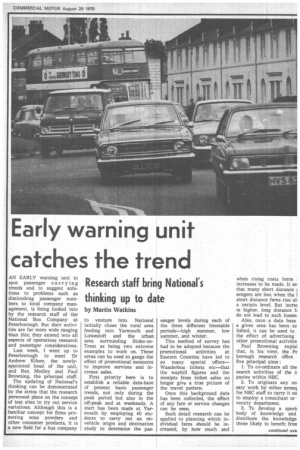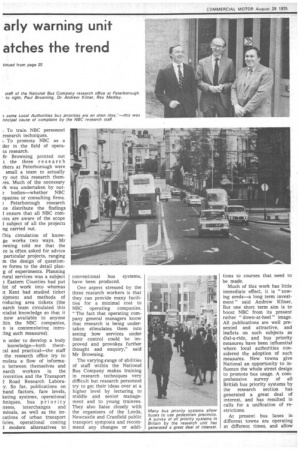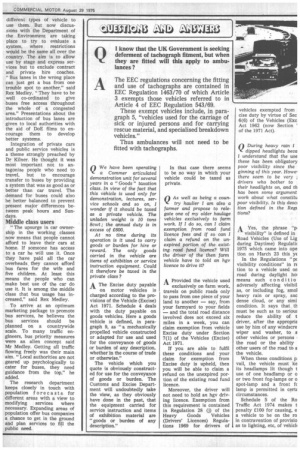Early warning unit catches the trend
Page 27

Page 28

Page 29

If you've noticed an error in this article please click here to report it so we can fix it.
Research staff bring National's thinking up to date
by Martin Watkins
AN EARLY warning unit to spot passenger carrying trends and to suggest solutions to problems such as diminishing passenger numbers to local company management, is being looked into by the research staff of the National Bus Company at Peterborough. But their activities are far more wide ranging than this; they extend into all aspects of operations research and passenger considerations.
Last week, I went up to Peterborough to meet Dr Andrew Kilner, the newlyappointed head of the unit, and Rex Medley and Paul Browning, the principal staff.
The updating of National's thinking can be demonstrated by the stress that the research personnel place on the concept of test sites to try out service variations. Although this is a familiar concept for firms promoting soap powders and other consumer products, it is a new field for a bus company to venture into. National initially chose the rural area feeding into Yarmouth and Lowestoft and the urban area surrounding Stoke-onTrent as being two extreme examples to work on. These areas can be used to gauge the effect of promotional measures to improve services and increase sales.
First priority here is to establish a reliable data-base of present basic passenger trends, not only during the peak period but also in the off-peak and at weekends. A start has been made at Yarmouth by employing 40 students to carry out an onvehicle origin and destination study to determine the pas senger levels during each of the three different timetable periods—high summer, low summer, and winter.
This method of survey has had to be adopted because the promotional activities at Eastern Counties have led to so many special offersWanderbus tickets etc—that the waybill figures and the receipts from ticket sales no longer give a true picture of the travel pattern.
Once this background data has been collected, the effect of any fare or service changes can be seen.
Such detail research can be applied to planning which individual fares should be increased, by how much and when rising costs force • increases to be made. It se that many short distance sengers are lost when the I short distance fares rise ah a certain level. But increi in higher, long distance fi do not lead to such losses.
Also, once a data base a given area has been es fished, it can be used to the effect of advertising other promotional activitie Paul Browning explai that, in his view, the Pe borough research office five principal aims : 1. To co-ordinate all the search activities of the c panies within NBC.
2. To originate any ne. sary work by either arra/.4 for NBC staff to carry it on to employ a consultant or • versity department.
3, To develop a speck body of knowledge and distribute the knowledge those likely to benefit fron To train NBC personnel research techniques.
To promote NBC as a der in the field of operaas research.
4r Browning pointed out t the three research rkers at Peterborough were small a team to actually ry out this research them/es. Much of the necessary rk was undertaken by out bodies—whether NBC npanies or consulting firms.
Peterborough research ce distribute the findings 1 ensure that all NBC cornlies are aware of the scope 1 subject of all the projects ng carried out.
Nils circulation of knowge works two ways. Mr Awning told me that the ce is often asked for advice particular projects, ranging m the design of questionre forms to the detail plang of experiments. Planning rural services was a subject t Eastern Counties had put lot of work into whereas ;t Kent had studied ticket iipment and methods of roducing area tickets (the earch team circulated this cialist knowledge so that it now available to anyone :hin the NBC companies, o is contemplating intro2ing such measures).
n order to develop a body knowledge—both theornil and practical—the staff the research office try to mulate a flow of informa n between themselves and earch workers in the iversities and the Transport I Road Research Laboray. So far, publications on nand factors, fare levels, keting systems, operational 'hniques, bus priority ;tems, interchanges and minals, as well as the imcations of urban transport licies, operational costing i modern alternatives to conventional bus systems, have been produced.
One aspect stressed by the three research workers is that they can provide many facilities for a minimal cost to NBC operating companies. "The fact that operating company general managers know that research is being undertaken stimulates them into seeing how services under their control could be improved and provokes further thought and enquiry," said Mr Browning.
The varying range of abilities of staff within the National Bus Company makes training in research techniques very difficult but research personnel try to get their ideas over at a higher level by lecturing to middle and senior management and to young trainees. They also liaise closely with the organisers of the Leeds, Newcastle and Cranfield public transport symposia and recommend any changes or addi tions to courses that need to be made.
Much of this work has little immediate effect, it is "sowing seeds—a long term investment" said Andrew Kilner, But one short term aim is to boost NBC from its present rather " down-at-heel " image. All publications are well presented and attractive, and leaflets on such subjects as dial-a-ride, and bus priority measures have been influential where local authorities considered the adoption of such measures. New towns give National an opportunity to influence the whole street design to promote bus usage. A comprehensive survey of all British bus priority systems by the research section has generated a great deal of interest, and has resulted in calls for a unification of restrictions.
At present bus lanes in different towns are operating at different times, and allow different types of vehicle to use them. But now discussions with the Department of the Environment are taking place to try to evaluate a system, where restrictions would be the same all over the country. The aim is to allow use by stage and express services but to exclude contract and private hire coaches. " Bus lanes in the wrong place can just get a bus from one trouble spot to another," said Rex Medley. "They have to be well co-ordinated to give buses free access throughout the whole of a congested area." Presentations about the introduction of bus lanes are given to local authorities with the aid of DoE films to encourage them to develop better systems.
Integration of private cars and public service vehicles is a theme strongly preached by Dr Milner, He thought it was most important not to antagonise people who need to travel, but to encourage transfer to buses by providing a system that was as good as or better than car travel. The demand for buses could also be better balanced to prevent present major differences between peak hours and Sundays.
Middle class users
"The upsurge in car ownership in the working .classes now means that people cannot afford to leave their cars at home. If someone has access to a car he will use it. Once they have paid all the car overheads they cannot afford bus fares for the wife and five children. At least this means the people who can make best use of the car do use it. It is among the middle class that bus usage has increased," said Rex Medley.
To arrive at an optimum marketing package to promote bus services, he believes the bus services should be planned on a countrywide scale. To many traffic engineers, bus priority measures were an alien concept said Mr Medley. Getting all traffic flowing freely was their main aim. "Local authorities are not geared up psychologically to cater for buses, they need guidance from the top," he added.
The research department keeps closely in touch with population forecasts for different areas with a view to modifying services where necessary. Expanding areas of population offer bus companies a chance to get in the ground and plan services to fill the public need.








































































